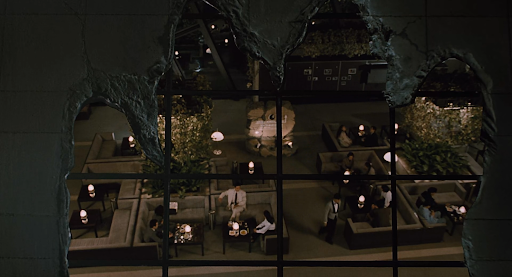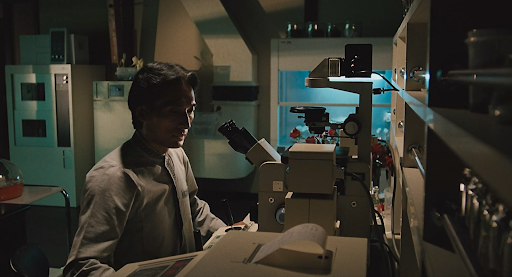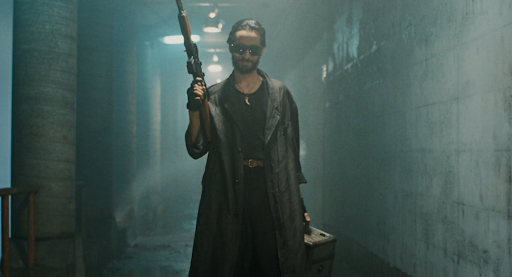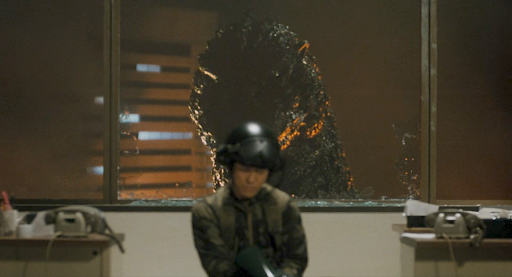Weird Wednesdays: Godzilla vs. Biollante
This screening was part of the Alamo Drafthouse’s Weird Wednesday series. For upcoming shows, click here.
Godzilla is Japan’s James Bond. Now hear me out.
Giant monster movies existed before 1954’s Godzilla the same way there were spy movies before James Bond’s first feature Dr. No. Both franchises seemed to arrive fully formed while they also went on to redefine the genres they represented. Both series have adjusted their formulas over the years to serve a diehard fanbase while also keeping pace with new trends. Thus, the two brands have remained flagships of their respective genres for their entire existence. Also like Bond, Godzilla movies of the late 1980s enjoyed something of an edgy renaissance after spending some time in the wilds of goofiness in the 70s.
My final comparison to James Bond: Even for the most casual viewer, Godzilla’s reputation precedes him. Don’t rile him and you won’t have any trouble. But today’s analysis is a Godzilla movie after all, and those pesky humans can’t help themselves! Gladly this entry in the series, 1989’s Godzilla vs. Biollante, does not require much from a new viewer. Continuity was reset in the previous series entry Return of Godzilla a.k.a. Godzilla 1985. There is even a scene set in the Godzilla Memorial Lounge: a restaurant/cafe in a refurbished toppled building, complete with a big Godzilla footprint repurposed as a skylight.
The movie opens with some action and espionage in the aftermath of the 1985 Godzilla attack. Japanese soldiers locate some Godzilla cells (perhaps he pricked his toe on one of those boxy mid-80s compact cars.) The troops have the cells stolen from them by some more Western-looking soldiers. Those soldiers are then in-turn mugged by a dashing secret agent known only by the codename “SSS9.” He is working for a petroleum company in the fictional middle eastern nation of Saradia.
This espionage plot runs through the movie. To paraphrase Fall Out Boy: This ain’t a scene. It’s a Godzilla arms race. It seems that all the major powers want Godzilla’s cells. Turns out it’s useful to have DNA from a guy with radioactive breath and the ability to swim through molten magma like it’s the ball pit at Chuck E. Cheese.
The next character introduced is Dr. Shiragami, who works for a petroleum firm in Saradia. Tragedy strikes when his daughter Erika dies in a rare non-Godzilla-related bombing. Turns out he was working on cloning and plants. Fast forward to five years later. He’s sworn off cloning and now he’s really into psychic research with his new protege Miki. In any event, these seem like useful areas of research for a super-scientist. If one was going to, just for example, create a monster to rival Godzilla.
There’s Lieutenant Gondo, a soldier who’s been waiting on the reappearance of Godzilla. While he has some good ideas for stopping Godzilla’s next attack, he’s been relegated to a desk job… for now.
We are also introduced to Sho Kuroki, the face of the JSDF (Japanese Self-Defense Forces) in this installment. He’s commander of the Super X-2, a Thunderbirds-esque hovering attack vehicle made specifically to fight Godzilla. (or at the very least annoy him with missiles and a special mirror that reflects his radioactive breath back at him.)
This demonstrates an issue that every Godzilla movie encounters. While he may be an international star with a deep back catalog, as a legacy entertainer Godzilla is only there to play the hits. He fights monsters and crushes apartment blocks. It falls on the supporting characters to be compelling and keep the viewer engaged between Godzilla attacks. Between the tenacious spies, battle-hardened soldiers, psychics and super scientists this bunch is up to the task.
All remaining plot elements are in orbit around Godzilla: when will he appear and who will he fight? This leads us to Biollante, one of the more unique entries in Godzilla’s section of the Kaiju menagerie. Biollante keeps things fresh as an outlier in both genus and species. A plant monster created from domestic roses, with some DNA from Godzilla and a dash of Dr. Shiragami’s daughter Erika peppered in. One of the strengths of Godzilla as a franchise is the deep bench of different monster types. It’s never quite as satisfying to have Godzilla fight another giant lizard by a different name.
Biollante escapes her confinement and takes root in nearby Lake Ashi. She has a large betoothed rose petaled head atop a glowing, tree-like body and undulating tentacle vines. Her design feels akin to Audrey II from Little Shop of Horrors. The effect looks amazing in the moody evening lighting of the effects shots, although I don’t know about sticking a rose of any size in a large body of standing water. Ideally for roses gardening guru Monty Don would recommend soil that drains well with a medium-heavy loam.
Godzilla himself has been resting cozily in a volcano since he was exiled there in 1985. The Bio-Major corporation plots to blow up the volcano to extort the Godzilla cells from the Japanese government. Thus Godzilla is awakened to wreak havoc on the population.
Another significant signpost of the time is the subplot about anti-nuclear energy bacteria, presented as a method to gobble up radioactive energy in a similar manner to petroleum degrading bacteria that’s used to clean up oil spills. Which was a new thing at that time.
To recap, we’ve got a real bouillabaisse of super-science: cloning, psychic powers, hi-tech hover tanks and corporate espionage. All in the service of a battle between Godzilla and a plant monster.
That monster battle happens about halfway through the movie and it’s everything you want from guys in a wading pool in monster getups. Biollante has tentacles with additional mouths that ensnare Godzilla. He in turn uses his nuclear breath to overload Biollante, causing her to explode in a cloud of sparkling spores. Add that to your allergy forecast.
These scenes effectively showcase the innovations over the older installments in the franchise. For instance, the Godzilla suit now has built-in lighting in the dorsal plates for when he’s about to let loose with nuclear breath. The practical lighting effect looks great.
Biollante defeated, the action returns to following the JSDF as they attempt to repel Godzilla. They use a combination of the Super X-2, the miracle bacteria and an artificial lightning field. This provides another cool set piece for the finale. Similar moody lighting, but this time with even more models and soldiers and cool sci-fi tanks that shoot lighting.
This final act also provides another twist on the classic formula that becomes de rigueur for Godzilla movies for years to come. Just when it seems Godzilla is undefeatable, Biollante reappears in a new evolved form and heightens her attack. She spits acid on Godzilla like the dilophasaurus in Jurassic Park. She spears him with vines. It’s only then that Godzilla uses a point blank nuclear breath attack to defeat Biollante once and for all. This releases poor Erika’s soul into the afterlife. Oh by the way, did I mention Erika’s spirit may have been trapped in Biollante? I watched this a couple of times, just to make sure I understood correctly. Perhaps I just don’t have the grasp on shintoism I thought I did.
In any event Biollante is defeated. Godzilla is weakened. The Japanese military use their lightning guns to heat up Godzilla, allowing the bacteria to do its thing. Feeling feverish, Godzilla returns to the ocean to cool down a bit. Not a total defeat, everyone agrees to call it a day until the next time. The final shot is a shot of a Biollante flower in Earth orbit that clearly references an earlier sci-fi classic, 2001: A Space Odyssey.
The 1980s created perfect conditions for blockbuster film making both in Hollywood and abroad. Science and technology were more sophisticated than they had ever been. This increased sophistication is reflected in both the plot and in the visual effects of the time. The combination imparted a realistic edge to even the most half-baked genre movies. An environment ideal for crops of science fiction blockbusters to blossom like 100-meter rose monsters.
Godzilla vs. Biollante takes full advantage of the innovations of the time and rewards the viewer with the craft on display. While the story is busy, it’s certainly not dull. This movie hits the sweet spot for a Kaiju fantasy, which is what gives this entry the longevity Godzilla still enjoys today. When the final credits roll, the viewer can remain assured that like James Bond, Godzilla will return.
If you enjoyed this article, please consider becoming a patron of Hyperreal Film Journal for as low as $3 a month!








Collin Cannaday is an Austin author, screenwriter, essayist, humorist, satirist and dramatist. He currently co-hosts the Are You Karate Kidding Me?! podcast recapping the Karate Kid movies and Cobra Kai. Subscribe on your podcatcher of choice. Follow him on Letterboxd: @ccann or on Bluesky: @collincannaday.com